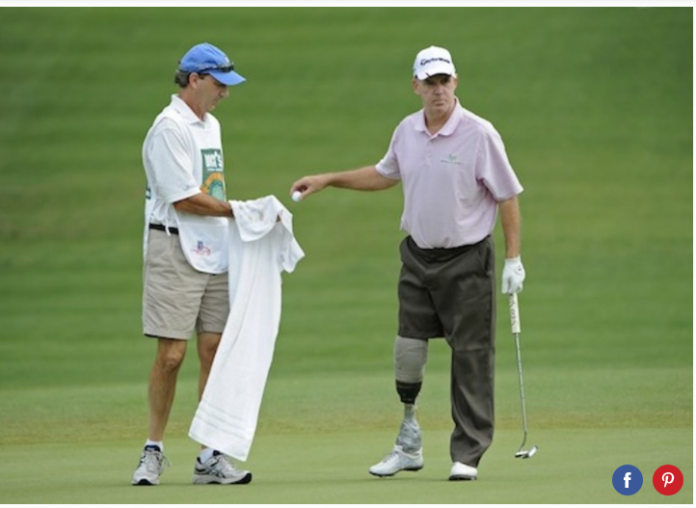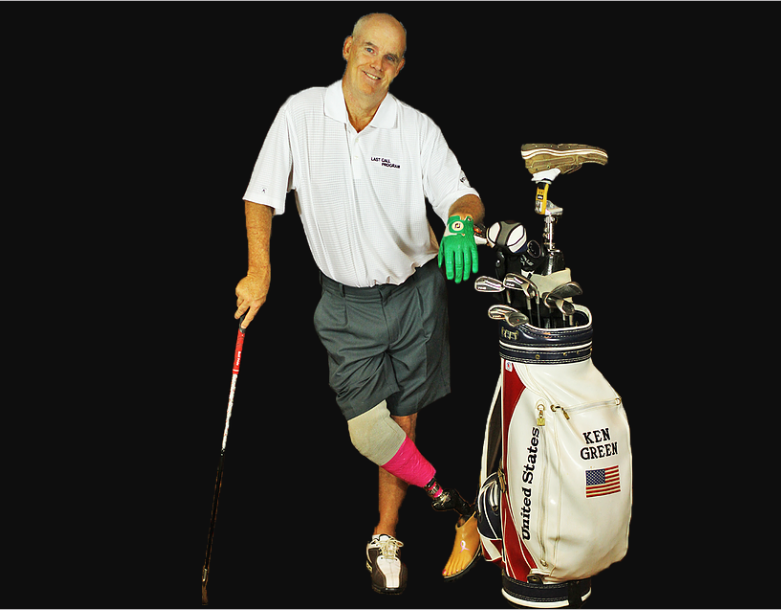
HARTFORD, Conn. – Danbury native Ken Green made another inspirational start this week in the Senior PGA Championship.
June 8 will mark the 10th anniversary of Green losing the lower part of his right leg in a horrific recreational vehicle accident that claimed the life of his brother Bill, girlfriend Jeanne Hodgin and German Shephard dog Nip.
After having 10 operations to try to alleviate constant pain in what is left of his leg, which was amputated at the knee and had him consider planning “to end it all” in his home in West Palm Beach, Fla., if peripheral nerve surgery wasn’t successful six years ago.
Green, who fought depression for years, told new girlfriend Kristin Carpenter and 31-year-old son Ken Jr. that he was going to commit suicide two days after his 55th birthday if having two nerves causing his problems implanted in the muscle in his hamstring didn’t dramatically curtail his excruciating pain. It would have been reminiscent of 21-year-old son Hunter, who died of a drug overdose in his dorm room at Southern Methodist University on Jan. 22, 2010.
“I wanted my son (Ken) to be OK, and he said he understood why I wanted to do it,” Green recalled. “My girlfriend didn’t like it, but she understood, too. She works in a hospice so she sees people dying and the pain they’re in all the time.
“I wasn’t depressed and didn’t really want to do it, but people had no idea what I had gone through. After four years, it was just too much so I was leaving. It’s not that I couldn’t live, but I’m a believer in life. I’d run out of juice and didn’t want to sit in my bed and do nothing for the next 25 years while in pain.”
Green chose July 25 to swallow enough pills to kill himself because his birthday is July 23, and three of his beloved dogs were born on July 22, 24 and 26.
“Between all the birthdays, I just figured I’d fill out the week,” said Green, whose charitable foundation is working to find homes for 22 canines.

Fortunately for Green and those who care about him, Dr. Ivan Ducic performed 21/4 hours of surgery at Georgetown University Hospital in Washington, D.C., that transformed the latest of 23 patients to have the procedure.
“He’d had some success 19 times, so I had pretty good odds,” Green said. “Right after I woke up, I could tell I had a big reduction in the pain. I’ve got a scar about a foot long – it really scared me – but I felt like a new person. There’s still some electric zapping, but it doesn’t last more than five minutes. Before, I could have nasty pain where I was on the floor and literally couldn’t move for two hours. But I believe it’s gone, and I don’t see why it’ll come back.”
After a month of recovery, Green resumed practicing and tied for 12th in his first competition, the Connecticut Senior Open at Shennecossett Golf Course in Groton, Conn.
“I’m not going to say I had a plan and was going to do x, y or z, but I was really losing it,” Green said during the 2014 Senior PGA Championship in Benton Harbor, Mich. “They say everyone comes to that wall. I was reaching that point of collapse.”
Fortunately, the surgery worked, and Green is still trying to live life to the fullest, which includes playing some “friendly” golf, PGA Tour Champions events when granted a sponsors’ exemption and usually the Connecticut Open, which he won in 1985 and 1992, and the Connecticut Senior Open, in which he tied for second only two years ago, while living in the state during the summer.
This week Green, who wears a right leg prothesis, competed in a major championship where he played in the 1989 U.S. Open, Oak Hill Country Club in Rochester, N.Y. He also was scheduled to start the promotion of his autobiography entitled, “Hunter of Hope,” which is dedicated to his late son.
“That was a killer,” Green said. “I had to tell myself, ‘Do I believe what I said get back up and fight’ or do I go to the bar and live a terrible life? I’ve been through a lot. You owe it to yourself to keep fighting no matter what happens in your life. Whatever happens, it’s OK to fail, get back up and try again. As weird as this sounds, this (the leg amputation) was almost like a second chance.”

But some positive developments led to the release of Green’s book being delayed until July 3.
“We were using this week as a good start (for the release) with all the media in town,” Green said in a personal blog entry. “But Golf Digest read my book and wants to run a piece in their August magazine and on their website. They clearly understood what a stunning life I have endured. It’s heroic, sinful, courageous, inspirational, depressing and other words that I can’t spit out.
“So now the release date is July 3, but for those who have pre-ordered, I will get the book to you well before that because I owe you that. I only ask that you don’t open the can of whoop ass so as to hurt my chances of success and, more importantly, to help others. The printer has guaranteed me the books will be here by the time I return from Oak Hill. We felt the potential reach of the buyers was just too much to pass up. If this book does well, I will be able to take my proposal of helping out all those in need to a different level.”
Green had hoped to spread his story and try to inspire others at PGA Tour Champions events, but the Dick’s Sporting Goods Open was the only tournament to grant a sponsors’ exemption to him in 45 requests at one point. But now the straight-shooting Green’s story is available to all in his book, which can be purchased at www.kengreen.com.
“I would have loved to play some Champions events, but they didn’t see the value in me being there,” Green said. “I understand I couldn’t compete with them, but I was willing to go to hospitals, talk to people, do whatever they wanted. I have a unique story to tell. I haven’t given up. I went through the bottom of the pit, but got back up. I’d be lying if I said I wasn’t disappointed in the tour or the players. They don’t understand what life is about at our age.”
Green has competed on the PGA Tour, PGA Tour Champions and Nationwide Tour and overseas, winning 11 times worldwide, including five on the major league circuit. He began playing competitive golf at age 12 in Honduras, where his father, Marty, was principal of the American school, and his only choices of sports were golf and soccer. He quit school at 16 to pursue his dream of becoming a professional touring golf pro.
Green attended Palm Beach Junior College in Lake Worth, Fla., for a year and then accepted an athletic scholarship to the University of Florida in Gainesville, where he played for coach Buster Bishop and coach John Darr’s Florida Gators men’s team in NCAA competitions in 1977-79. He was a second-team All-Southeastern Conference selection in 1979, when he turned pro and then joined the PGA Tour a year later.
All five of Green’s PGA Tour wins came in the mid-to-late 1980s, usually with sister Shelley on his bag. His first victory came in the 1985 Buick Open and his last in the Kmart Greater Greensboro Open in 1989, when he made his only U.S. Ryder Cup team. His best year was 1988, when he won twice on the PGA Tour and the Dunlop Phoenix in Japan. His best finish in a major championship was a tie for seventh in the 1996 U.S. Open.
During his professional career, Green has had a reputation for being rebelliousness and pulling stunts that led to two dozen fines levied by the PGA Tour. Some of his bad-boy antics included sneaking friends into the Masters in the trunk of his car and playing the Par-3 course, having a beer on the 15th hole while playing with Arnold Palmer for the first time in the 1997 Masters and hitting golf balls through narrow openings in sliding-glass doors.
Then there was his Masters debut in 1986 when he shot a 4-under-par 68 to share the first-round lead with caddie/sister toting his bag. He and Shelley regaled the fawning media for more than an hour, but when Ken was asked what he thought when he first drove down Magnolia Lane at Augusta National Golf Club, he must have caused tournament co-founders Bobby Jones and Clifford Roberts to roll over in their graves.
“I’ve seen better drives in northwestern Connecticut,” Green said.
So much for all of that goodwill with the Fourth Estate and television commentators worldwide for the previous 90 minutes. It was another Ken Green classic, again proving my contention to him that he was one of the best interviews in the history of sports but had a difficult time shutting off the faucet.
Other fines were for more mundane offenses such as swearing on the course, criticizing officials and signing autographs while playing. His personal problems – divorces, gambling and clinical depression – led to near financial ruin and affected his playing time and the quality of his play. In his 40s, Green had difficulty maintaining his PGA Tour playing privileges and was forced to play some on the Nationwide Tour.
Green often played tournaments dressed in green from head to toe, shoes included. He had 508 PGA Tour starts, the last coming in 2006, and has been an avid bowler who once rolled a 300 game. In 2003, he jumped into a canal near his home in West Palm Beach to save his dog from the jaws of an alligator. But Nip, his brother and girlfriend were killed when Green’s motor home left the road on June 8, 2009. They were traveling home on Interstate 20 near Meridian, Miss., when the right front tire blew, causing the vehicle to veer off the road and down a deep embankment before hitting a tree. Even though Green’s lower right leg was amputated just above the knee as a result of injuries suffered in the accident, he vowed to return to golf and has been playing in varying amounts ever since.
In 2017, two-time Greater Hartford Open champion Paul Azinger told Golf Channel that Green is “the most courageous man in the world.” That might be a bit of hyperbole, but Azinger has also been known as a straight shooter. And when Green was inducted into the Connecticut Golf Hall of Fame in 2006, he gave the most inspirational speech that many longtime onlookers had ever heard. This from an individual who never knows what the pain level will be like coming from his prosthetic each morning.

“I literally have no idea what will happen,” Green said. “I go home, take the leg off and have no idea how the nerves will react. No matter how many pain meds I have, it doesn’t stop it.”
And neither has his hope of helping others.
“I haven’t been known for inspiring people throughout my career,” Green said at his post-accident debut in the 2010 Liberty Mutual Legends of Golf in Savannah, Ga. “But I’ve got a chance to do something good for people, something important in golf, and for people who are disabled, and people who have had accidents.”
This week, Green just tried to enjoy what he could in another major championship. When he played at Oak Hill CC 20 years ago, he said the course seemed hard but not impossible. Now, Oak Hill is “a beast of a course” on which Green thinks the winning score will be over par. He hit only one green in regulation in the 13 holes that he played in practice Wednesday with close friend Mark Calcavecchia and Russ Cochran.
“I watched Calc and Russ struggle, so I know it’s not all me and my lack of distance,” Green said. “Over par wins there, I think.”
Green said the course was in “absolutely perfect shape. It’s orgasmic just walking on the fairways or watching the ball roll on the greens.”
Green played the first two rounds with Peter Fowler and Omar Uresti but isn’t around for the weekend after shooting 22-over-par 162 for 36 holes. He tied four players and beat six, four of whom withdrew, but scores were irrelevant since Green was still fulfilling his dream of playing competitively nearly 10 years after his tragic accident.











Leave a Reply